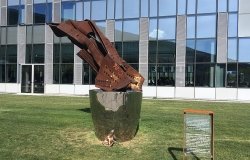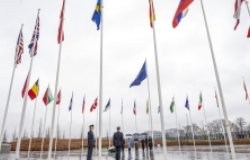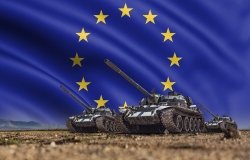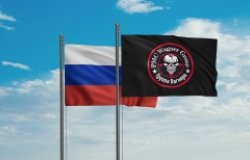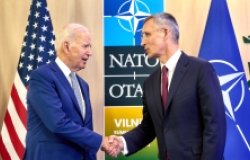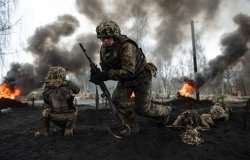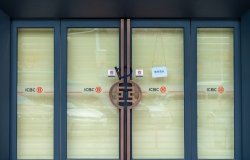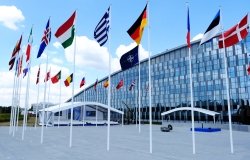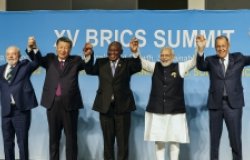353. Blue Helmets and Black Markets: The Business of Survival in the Siege of Sarajevo
Peter Andreas is Associate Professor of Political Science and International Studies at Brown University. He spoke at an EES Noon Discussion on October 2, 2008. This essay is adapted from Blue Helmets and Black Markets: The Business of Survival in the Siege of Sarajevo (Cornell University Press, 2008). Meeting Report 353.
Inside the UN-run airport in besieged Sarajevo hung a makeshift sign: Maybe Airlines. Along the edges of the sign, aid workers, journalists, and diplomats had posted stickers—CNN, ITN, CBS, RTL, MSF, VOX, UNICEF, the French flag, the Canadian flag, the Swedish flag and so on. Above the sign was a piece of plywood with the word destinations hand-written at the top, with a changeable placard below (the placard choices included New York, Geneva, Rome, Berlin, Zagreb, Paris and Heaven). Maybe Airlines was the nickname given to the unreliable UN flights in and out of wartime Sarajevo—the longest airlift ever attempted and the centerpiece of the international humanitarian response to the war in Bosnia and Herzegovina. Meanwhile, underneath the airport tarmac ran a narrow and damp 800-meter-long tunnel that bypassed both UN controls and the siege lines. Protected from Serb shelling and sniper fire, thousands of people and tons of food, arms and other supplies moved through the underground passageway every day (which the UN pretended did not exist), providing both a vital lifeline for the city and an enormous opportunity for black market profiteering. While the UN airlift was part of the highly visible front-stage of the siege, the tunnel was part of the much less visible but equally important backstage action. Together, they helped Sarajevo survive for more than three-and-a-half years, setting a siege longevity record.
The 1992-1995 battle for Sarajevo was not only the longest siege in modern history but also the most internationalized: it became an urban magnet for aid workers, diplomats, UN "Blue Helmet" soldiers, journalists, artists, celebrities, peace activists, adventure seekers, embargo busters and black-market traders. Sarajevo under siege became the most visible and recognizable face of post-Cold War "ethnic conflict" and humanitarian intervention. At the same time, the less visible and less recognized face of the siege included aid diversion, clandestine commerce and peacekeeper corruption. As the Sarajevo experience powerfully illustrates, just as changes in fortifications and weapons technologies transformed siege warfare through the ages, so too has the arrival of CNN, NGOs, satellite phones, UN peacekeepers, aid convoys and diaspora remittances. The internationalization of the siege changed the repertoires of siege-craft and siege defenses. It changed the strategic calculus and opportunities and constraints of both the besiegers and the besieged.
The tortuous, globally televised battle for the Bosnian capital came to represent the entire post-Cold War experience of ethnic conflict, UN hand wringing, Western paralysis, questionable humanitarianism, and a mushrooming global relief aid industry. Like the Rwandan camps in Goma, ex-Zaire, Sarajevo became an embarrassing symbol of Western failure and incompetence, prompting Hollywood movies and a myriad of journalistic polemics. Outrage over events in Sarajevo, one could argue, helped pave the way for more robust international military intervention in Kosovo at the end of the decade, and contributed to the U.S. turn away from UN-led multilateral conflict resolution initiatives.
Given the overwhelming military advantage of the Serb besiegers, many at first expected the poorly defended city and its Muslim-led government to fall quickly and easily. At the same time, given the intensity of international political and media attention, many expected that the Serb leadership would back down and the siege would be short-lived. It did not turn out that way. Why not? What sustained the siege for such an unexpectedly long period of time? These questions are particularly puzzling because siege warfare in Europe was supposed to be obsolete—and in Sarajevo it was not only back with a vengeance but, contrary to all expectations, stubbornly persisted. Moreover, it was being broadcast live across the globe. As David Rieff described it: "A European city was being reduced to nothing; Carthage in slow motion, but this time with an audience and videotaped record."
The siege of Sarajevo is not simply a fascinating and important historical story. The siege offers a powerful lens through which to scrutinize the relationship between the material and performative aspects of conflict, international intervention, and post-war reconstruction. In a highly confined and intensely contested geographic space, the siege provides a striking illustration of the interdependence between the upper-world and underworld, formal and informal, front stage and backstage in armed confrontations and external involvement. At the broadest level, the story of Sarajevo is about the dynamics of war economies, humanitarian and media access to conflict zones, and the political repercussions of relief. More specifically, issues of aid diversion, embargo busting, trading with the enemy, war profiteering and irregular combatants all come together and crystallize in the Sarajevo case. In concentrated form, the siege illuminates important elements of the political economy of contemporary conflict and the dilemmas, contradictions and unintended consequences of humanitarian action.
The internationalization of the siege, which aimed to end the conflict, paradoxically helped to perpetuate it by becoming incorporated into the war economy. Many observers have argued that the Sarajevo siege (and the wider war in Bosnia) was prolonged by international intervention, particularly the large-scale delivery of humanitarian aid. But the specific mechanism through which this was accomplished goes well beyond the one usually described. It was not only the official aid that prolonged the siege, but also the business opportunities that the UN-led Sarajevo relief operation created for local black market transactions. The injection of aid, peacekeepers and other international actors into the besieged city provided an opportunity for a criminalized war economy to flourish. Importantly, international actors on the ground were incorporated and absorbed into the war economy rather than simply kept out or driven out by it.
International intervention prolonged the siege not only due to the transfer of official aid, but also because it helped to create a lucrative environment for black marketeers, who were empowered to trade across frontlines, slip in and out of closed areas, transform humanitarian supplies into hard currency and obtain access to weapons and other vital war supplies. Once the siege lines became more settled, informal cross-frontline trading relations developed, greatly benefiting from the stabilizing influence of the UN's presence (and sometimes direct complicity). Thus, official international recognition and relief aid were insufficient causes for the prolongation of the siege; Sarajevo's survival cannot be explained without taking into account cross-frontline smuggling practices and the criminalized defense effort. This is not to suggest that the siege was deliberately prolonged to enrich black marketeers, but rather that such clandestine entrepreneurial activities were essential for Sarajevo's remarkable survival.
The Sarajevo siege was particularly supportive of the black market because it created formally impermeable spaces—front lines—that were closed to most locals, but permeable for many internationals and well-placed Bosnians. The siege lines thus functioned like a heavily policed border—and as elsewhere, borders and border controls generate tremendous incentives and opportunities for smuggling. These incentives were especially powerful in the case of Sarajevo since the city was essentially a large captive market with astronomical price differentials from one side of the siege line to the other. The business of survival in besieged Sarajevo thus involved continually negotiated access across these lines—keeping the siege permeable through formal channels in the form of delivering official aid, and informal channels in the form of smuggling people, goods and money. Both channels were intimately intertwined, representing the front-stage and backstage action in the prolonged siege drama.
An emphasis on the formal and informal political economy of the siege provides an antidote to the obsessive focus on ethnic identities and animosities in the Bosnia conflict. In the case of Sarajevo, ethnicity certainly mattered, but does not take us very far in explaining the longevity of the siege. Ethnicity as a master narrative simply does not hold up to close scrutiny when looking at the messy and complex micro-dynamics on the ground. While the mobilization and political manipulation of ethnic nationalist animosities helped to bring about the siege, an ethnicity-driven narrative would not expect and cannot account for the various forms of clandestine cross-ethnic exchange that helped sustain Sarajevo under siege. Ethnicity cannot explain the considerable variation in local relations across the siege lines, including levels of violence and permeability. These variations were also not always reducible to a simple strategic calculus of maximizing military advantage. The high levels of clandestine cross-frontline trading, the intensity of global attention, the multiple formal and informal roles played by key local and international actors, and the city's stubborn endurance do not fit neatly within a realist understanding of unitary actors pursuing their security interests. At the same time, a focus on the criminalizing effects of the UN-led intervention does not sit comfortably with (and tends to be glossed over by) many liberal advocates of humanitarian responses to conflict.
Over time, a peculiar and in many ways unintended symbiosis developed on the ground between key actors among the besiegers, besieged and external interveners. Pointing to the symbiotic aspects of the Sarajevo siege is not meant to suggest that the besieged and the international interveners did not want the siege lifted, that the besiegers would not have preferred a quick and decisive military victory, or that all sides benefited equally from the siege and were equally responsible for its continuation. However, it does draw attention to the ways in which moves on all sides often ended up being reinforcing, even if this was unintentional. No elaborate conspiracy was required, making the siege symbiosis all the more durable.
For many local and international actors, the partial and continuously negotiated permeability of the city made the siege politically tolerable, militarily acceptable and economically profitable. Siege dynamics were often more about controlling humanitarian supplies and smuggling routes in and out of the city than with making the siege militarily succeed or fail. While the vast majority of the city's inhabitants struggled for survival and lived in a state of terror, a semi-porous siege kept the city formally and informally supplied and served various local and international interests. Dissecting the anatomy of the siege shows how and why it proved to be not only sustainable but also rewarding for some key players on all sides. For the nationalist Serb besiegers, the siege kept the city bottled up and useful as a political lever and as a distraction from more severe atrocities elsewhere. For the inner circle of Sarajevo's political leadership, the siege helped them maintain power, consolidate their party's political position, marginalize opponents and generate and sustain international sympathy and support. For the UN and its western sponsors, the siege provided a remarkably viable working environment to showcase aid provision in the Bosnian war, avoid more direct military entanglement and contain the flood of refugees. For foreign journalists, the siege offered a front row seat in a high drama spectacle and the most accessible war zone in Bosnia. Finally, for well-placed black market entrepreneurs on all sides, the siege conditions assured a captive market with highly inflated profits. As described by Hasib Salkic, the secretary general of the Liberal Party of Bosnia, the siege was "The best course in market economy one can get. I learnt it and I use it today. Naturally some used it as education, some for getting rich, for wheeling and dealing, for stealing."
The point here is not to provide a polemic against crime, corruption and black market profiteering. The primary purpose is to explain and understand rather than to expose and condemn. All too often, denouncements of corruption and criminality substitute for critical evaluation and fuel politically-motivated speculation. Rather than simply joining the chorus of voices loudly condemning such behavior, I stress its double-edged character: the criminalized side of the conflict involved both looting and saving Sarajevo, it contributed to both the persistence and the end of the war, and it fostered both state formation and deformation. Equally important, an analytical focus on the criminalized dimensions of the siege is not meant to discredit the remarkable defense of Sarajevo and survival skills of its inhabitants. I do not wish to diminish the heroics and sacrifices of Sarajevo's citizens but rather to shed light on a dimension of the conflict that is too often either neglected or distorted. Crucially, this includes acknowledging and critically evaluating the role of international actors and their interaction with local players in shaping and enabling the criminalization of the siege and wider war. Indeed, as I stress, the particular mode of external intervention was critical in turning the conflict into such an enormous black market business opportunity.
Focusing on the role of black market operators, criminals-turned-combatants, and smuggling networks runs the risk of exaggerating their importance, providing an overly criminalized narrative of the siege. In its crudest form, this can generate a knee-jerk cynical dismissal of all actors as simply greedy and corrupt. It is not my intention to reduce the dynamics of the siege merely to crime and profiteering. This is only one (albeit important) dimension of a complex conflict. The point is not to entirely invalidate or supplant other accounts, but rather to incorporate and shed analytical light on a commonly overlooked or misunderstood aspect of the siege and wider war. Moreover, the criminalized component of the conflict has left a powerful legacy—including the emergence of new elites who profited from the war and the persistence of politically protected wartime smuggling networks—that needs to be more fully taken into account in understanding the chal
About the Author
Peter Andreas

Global Europe Program
The Global Europe Program is focused on Europe’s capabilities, and how it engages on critical global issues. We investigate European approaches to critical global issues. We examine Europe’s relations with Russia and Eurasia, China and the Indo-Pacific, the Middle East and Africa. Our initiatives include “Ukraine in Europe” – an examination of what it will take to make Ukraine’s European future a reality. But we also examine the role of NATO, the European Union and the OSCE, Europe’s energy security, transatlantic trade disputes, and challenges to democracy. The Global Europe Program’s staff, scholars-in-residence, and Global Fellows participate in seminars, policy study groups, and international conferences to provide analytical recommendations to policy makers and the media. Read more
